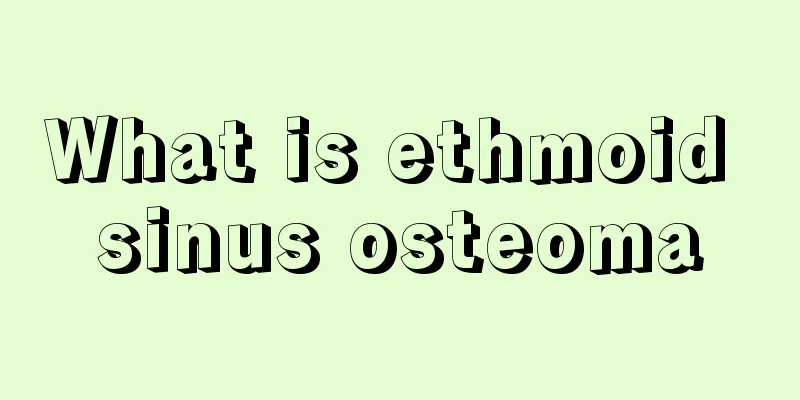What is ethmoid sinus osteoma

|
Tumors are a common phenomenon that occurs in people's body structures, posing a great threat to people's physical health and life safety. There are many types of tumors, and I believe that many of them are not familiar to people in their daily lives. For example, ethmoid sinus osteoma is a tumor that is not very common in daily life. Most people don't know much about this type of tumor, let alone what causes it. If you are not very clear about ethmoid sinus osteoma, you can learn more about it through the following article. Sinus osteoma is the most common benign tumor of the nasal cavity and paranasal sinuses. It grows slowly and is a benign bone tumor with an encapsulation. It usually causes no clinical symptoms and is occasionally detected on x-ray examination. It is reported that bone tumors can be detected in about 1% of subjects during routine sinus X-ray examinations; and the detection rate of bone tumors in patients who undergo sinus CT scans due to nasal and sinus symptoms is about 3%. The incidence of sinus osteoma is about 0.01%~0.43%; the male to female ratio is about 1.5:1~3:1; it can occur at any age, with the highest incidence age group being 20~50 years old; there is no racial bias. It is generally believed that sinus osteomas mostly occur in the frontal sinus, followed by the ethmoid sinus, maxillary sinus, and sphenoid sinus. In this regard, a recent prospective study has different results: 1,889 patients underwent sinus CT scans due to nasal and sinus diseases. The results showed that sinus osteomas most often occurred in the ethmoid sinus, followed by the frontal sinus, maxillary sinus, and sphenoid sinus, but the detection rate of osteoma was about 3%, which is consistent with previous literature reports. The cause of osteoma is still unclear. There are currently three classic theories: embryological theory, traumatic theory and infectious theory. The embryonic theory holds that bone formation is active and development is abnormal at the junction of the ethmoid bone (endochondral bone formation) and the frontal bone (intraperiosteal bone formation), but this theory cannot explain the occurrence of many osteomas that are not located at the fronto-ethmoid junction. The trauma theory holds that injuries during adolescence, the period of most active bone growth, are likely to lead to osteoma. However, a large proportion of patients have no history of trauma. The infection theory holds that sinusitis stimulates the proliferation of osteoblasts in the sinus mucoperiosteum and forms osteomas, but most scholars currently prefer that sinusitis is caused by osteomas blocking the opening of the sinuses. Osteomas generally occur in the bony walls of the sinuses and then grow into the cavity. They may have a pedicle or a broad base, a smooth surface, and be covered with normal mucosa. Histologically, osteomas can be divided into three different types: compact osteoma is composed of compact bone, also known as ivory-type or hard osteoma; spongy osteoma is composed of cancellous bone, also known as spongy or soft osteoma; mixed osteoma is a mixture of compact osteoma and cancellous osteoma, characterized by being hard on the outside and loose on the inside. If the bone tumor in the sinus falls off from the root and forms dead bone, it is called "dead osteoma". In addition, a bone tumor with a diameter >30 mm is called a giant osteoma. Most sinonasal osteomas do not cause clinical symptoms and are occasionally discovered during radiographs or CT scans. About 5% of sinonasal osteomas have clinical symptoms, the most common of which are facial pain and headache. Generally speaking, sinus osteomas grow slowly, about 0.44~6.0 mm/year, with an average of 1.66 mm/year. Initially, the osteoma occupies the local sinus and then invades the adjacent orbit or intracranial cavity, causing intraorbital and intracranial complications. Osteomas that are not completely removed may continue to grow. Malignant transformation rarely occurs. Sinus CT scan and sinus X-ray examination are the most commonly used methods for diagnosing sinus osteoma. CT scan shows uniform, dense, and clearly defined lesions. Preoperative biopsy is generally not necessary. Most scholars believe that patients with asymptomatic sinus osteoma do not need surgery and can choose "imaging examination and follow-up" as a countermeasure. Symptomatic patients and patients with rapidly growing bone tumors require surgical treatment. Clinical manifestations of ethmoid sinus osteoma Clinically, ethmoid sinus osteomas may be asymptomatic, or may present with headache, facial pain, or intraorbital complications and/or intracranial complications as the first symptoms. Most sinonasal osteomas grow slowly, do not cause clinical symptoms, and are occasionally discovered on X-rays or CT scans. A total of 1,889 patients underwent sinus CT scans for nasal and sinus diseases, and 57 cases (64 times) of sinus osteoma were found, of which 21 were accompanied by pathological changes in the sinuses [3]. In another study of 1,500 patients undergoing sinus CT scans, 46 sinus osteoma were found (including 9 ethmoid osteoma), of which only 2 had clinical symptoms and 3 received surgical treatment. The most common symptoms of ethmoid sinus osteoma are headache and facial pain. Compared with other bone tumors, ethmoid sinus osteomas are more likely to block the drainage channel of the ethmoid sinus and damage the mucociliary transport system, resulting in clinical symptoms of sinusitis such as nasal congestion, runny nose, decreased sense of smell, and postnasal drip. Therefore, many scholars believe that headaches and facial pains occur due to ethmoid sinus osteoma complicated by sinusitis. Ethmoid sinus osteoma may also present with intraorbital complications and/or intracranial complications as the first symptom. The following orbital complications caused by ethmoid osteomas have been reported in the literature: exophthalmos, orbital cellulitis, epiphora, restricted eye movement, ptosis, diplopia, decreased vision and even blindness. Similarly, there are also some reports of intracranial complications caused by ethmoid osteomas, such as two brain abscesses caused by frontoethmoid osteomas, pneumocephalus caused by ethmoid osteomas entering the anterior cranial fossa and eroding the dura mater, posterior ethmoid osteomas extending to the anterior skull base leading to cerebrospinal fluid rhinorrhea, meningitis, and frontoethmoid osteomas complicated by intracranial mucocele. 3. Surgical indications for ethmoid sinus osteoma When ethmoid sinus osteoma is complicated by intracranial or intraorbital complications, or is combined with chronic rhinosinusitis, and symptoms such as nasal congestion, runny nose, and headache occur, surgical treatment is required, and there is currently no objection. When ethmoid sinus osteoma presents only the most common symptoms of headache and facial pain, many scholars recommend first excluding diseases such as migraine and vascular headache before deciding whether to undergo surgery. Whether surgery is necessary for patients with asymptomatic ethmoid sinus osteomas is controversial. Due to the honeycomb-like structure of the ethmoid sinus, ethmoid sinus osteoma is more likely to block the drainage channel of the ethmoid sinus, resulting in sinusitis, mucocele and various intracranial and intraorbital complications. Generally speaking, patients with asymptomatic ethmoid sinus osteoma can choose the countermeasure of "imaging examination and follow-up". However, if the process of "imaging examination and follow-up" finds that the osteoma grows rapidly, occupies the sinus cavity, expands to the frontal recess and occupies 1/2 of the frontal sinus opening, or complications occur, surgical treatment is required. 4. Surgical approach for ethmoid sinus osteoma The surgical approach for resection of ethmoid sinus osteoma can be divided into transnasal approach, extranasal open approach or transnasal and extranasal combined approach. Traditional extranasal open surgery includes lateral nasal incision approach, craniofacial combined approach, midface flip surgery and other procedures, but whether this method is the best choice has always been controversial. The popular surgical method in the past few decades was to make an external incision on the nose to expose the bone tumor and use a hammer and bone chisel to remove the tumor. However, it would bring a series of unavoidable problems such as cerebrospinal fluid rhinorrhoea, damage to surrounding structures, facial scars, etc. Later, ear electric drills were used instead of chisels, but problems such as severe damage, heavy bleeding, and facial scars still existed. The endoscopic nasal surgery technology, high-resolution CT scanning and three-dimensional reconstruction technology, navigation technology, electric drill and other equipment developed in the past 20 years have provided technical and equipment guarantees for the transnasal resection of ethmoid sinus osteoma. The advantage of endoscopic resection of ethmoid osteoma is that it overcomes the disadvantages of open surgery and is considered to be the preferred approach for resection of frontoethmoid osteoma located in the ethmoid sinus or near the midline. |
<<: Methods to control tumor growth
>>: X-ray manifestations of osteochondroma
Recommend
What stage is thyroid cancer when it breaks through the capsule? What are the diagnostic methods for thyroid cancer when it breaks through the capsule?
What stage is it if thyroid cancer breaks through...
Propolis has antibacterial and anti-inflammatory properties
Many people have drunk honey in their daily lives...
Can dishwashing liquid still be used after it expires
Can we use the dishwashing liquid after it expire...
The strongest aphrodisiac wine recipe
In fact, using a combination of medicinal materia...
What are the diet recipes for lung cancer
Nutritional diet for lung cancer patients. Lung c...
What foods can't be eaten by bile duct cancer
Sometimes you cannot eat as you please. Paying at...
How to enhance immunity
Immunity is really important for a person. If a p...
Why can't I sleep after drinking?
Today's society is developing very rapidly, a...
Chinese medicine for treating sore throat
Traditional Chinese medicine is a kind of medicin...
How to choose a specialized hospital for bladder cancer
Once afflicted with bladder cancer, patients will...
What oil is healthy for cooking
It is well known that oil is a must for cooking. ...
Metformin's blood sugar lowering principle
The physical fitness of modern people has serious...
What are the early symptoms of prostate cancer?
Prostate cancer does not have obvious symptoms in...
The dangers of drinking hot water from a plastic cup
Winter is here again and many people are often su...
What does it feel like when the left ovary ovulates?
The ovaries play an important role in female repr...









